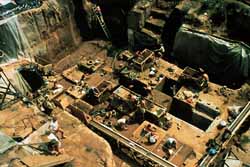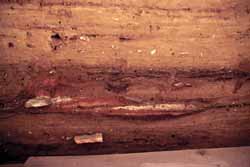
 |
Aerial overview of Koster site excavation in Greene County. | |
|
Between 1969 and 1978, archaeologists from Northwestern University excavated an extraordinary site on Theodore and Mary Koster's farm. University students spent 10 weeks each summer excavating with shovels and trowels in search of artifacts. They found thousands of artifacts that provide clues about life during the Archaic period. |
||
Koster site
American Indians used this site in the lower Illinois River valley with relatively few interruptions from 8,700 years ago until around 800 years ago. Evidence spanning 300 or more generations of American life was documented at the site through years of archaeological field work and study in the 1970s.
Artifacts from one of the deepest levels of the excavation (circa 8,500 years ago) document the beginnings of a more settled Archaic way of life. Many important discoveries were made here, including some of the oldest evidence of the use of ground stone for food preparation, the establishment of a cemetery for deceased members of the community, and the presence of domesticated dogs.
As one of the earliest cemeteries in eastern North America, Koster provided evidence that Early Archaic people had special rituals for burying the dead, including carefully positioning them in prepared oval pits.
Middle Archaic cemeteries were established near the village and on a bluff crest overlooking the Illinois River valley. Differences in treatment of the dead based on age and sex suggest differences in social status.
A variety of ground-stone tools were found in the oldest camps at Koster including axes, adzes for woodworking, metates and manos for food grinding, and hammer stones for stone tool production. These tools represent many different activities typically found in long-term or often revisited camps.
 |
Profile wall at Modoc Rock Shelter in Randolph County showing layers of occupations. | |
|
In some places, archaeologists find evidence of the past that is especially well preserved. Modoc Rock Shelter is a small indentation at the bottom of a rock cliff at the edge of the Mississippi River valley. The indentation is large enough for many people to find shelter from precipitation and wind. Over thousands of years, Native Americans lived periodically beneath the rock ceiling at Modoc Rock Shelter. |
||
Modoc Rock Shelter
In Randolph County, Illinois, the rock cliff at the edge of the Mississippi River valley was undercut by Ice Age floods. The undercut section of the cliff provided shelter from wind and rain, and Native Americans took advantage of it at least 9,000 years ago. The Modoc Rock Shelter, as it is called today, was used by Archaic hunting and gathering peoples who relied on nearby flood plain and upland resources. Over 28 feet of sediment in the shelter contains artifacts spanning more than 6,000 years of prehistory.
How did 28 feet of dirt end up in the shelter? The elevation of the Mississippi River flood plain has increased over time. Each time the river floods, it transports dirt eroded upstream and deposits it downstream. Over the last 10,000 years, the Mississippi River has been slowly filling its valley. The change in flood plain elevation also affects Mississippi River tributaries, which also deposit dirt in their valleys. As a result, over time, dirt has slowly accumulated in Modoc Rock shelter, burying the remains of previous occupations.
Based on an analysis of artifacts from the site archaeologists discovered that 9,000 years ago, the rock shelter was used for short-term camps by small groups of hunters By 6,000 years ago, Modoc Rock Shelter was used for a long-term base camp by several families involved in the activities of everyday life. Four thousand years ago, the shelter again was used by small hunting parties.
|
|
Copyright © 2000 Illinois State Museum